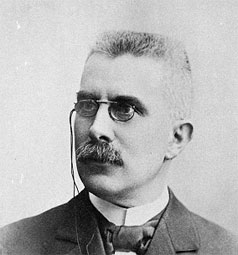<Back to Index>
- Chemist Henry Louis Le Chatelier, 1850
- Painter Max Slevogt, 1868
- Indonesian Freedom Fighter Ernest François Eugène Douwes Dekker, 1879
PAGE SPONSOR

Henry Louis Le Chatelier (8 October 1850 - 17 September 1936) was an influential French chemist of the late 19th and early 20th centuries. He is most famous for devising Le Chatelier's principle, used by chemists to predict the effect of a change in conditions on a chemical equilibrium.
Le Chatelier was born on 8 October 1850 in Paris and was the son of French engineer Louis Le Chatelier and Louise Durand. His father was an influential figure who played important roles in the birth of the French aluminium industry, the introduction of the Martin - Siemens processes into the iron and steel industries, and the rise of rail transportation. Le Chatelier’s father had a great influence on his son's future career. He had one sister (Marie) and four brothers (Louis 1853 - 1928, Alfred 1855 - 1929, George 1857 - 1935 and André 1861 - 1929). His mother raised the children according to very rigorous and strict principles, described by her son Henry: "I was accustomed to a very strict discipline: it was necessary to wake up on time, to prepare for your duties and lessons, to eat everything on your plate, etc. All my life I maintained respect for order and law. Order is one of the most perfect forms of civilization.".
As a child Le Chatelier attended the Collège Rollin in Paris. At the age of 19, after only one year of instruction in special engineering, he followed his father's footsteps and enrolled in the École polytechnique on 25 October 1869. Like all the pupils of the polytechnique, in September 1870 Le Chatelier was named second lieutenant and took part in the Siege of Paris. After achieving brilliant results in his technical schooling he entered the École des Mines in Paris in 1871.
He
married Geneviève Nicolas, a friend of the family and sister of
four fellow polytechnicians. They had seven children, four girls and
three boys. Five of the seven children went on to careers in the
scientific world. Two of his children passed preceding his own death. Despite
training as an engineer, and even with his interests in industrial
problems, Le Chatelier chose to teach chemistry rather than pursue a
career in industry. In 1887, he was appointed head of the general
chemistry to the preparatory course of the École des Mines in
Paris. He tried unsuccessfully to get a position teaching chemistry at
the École polytechnique in 1884 and in 1897. At the Collège de France, Le Chatelier succeeded Schützenberger as chair of inorganic chemistry. Later he taught at the Sorbonne university, where he succeeded Henri Moissan. The subjects which Le Chatelier taught at the Collège de France were: After
four unsuccessful efforts (1884, 1897, 1898 and 1900), Le Chatelier was
elected to the Académie des sciences (Academy of Science) in
1907. He was also elected a member of the Royal Swedish Academy of Sciences in 1907. In chemistry, Henry is known for his work on the principle of chemical equilibrium (known as Le Chatelier's principle)
and on the variation of the solubility of salts in an ideal solution.
He published approximately thirty papers on these subjects between 1884
and 1914. His results on chemical equilibrium were presented in 1885 at
the Académie des sciences in Paris. Le
Chatelier also carried out extensive research on metallurgy and was one
of the founders of the technical newspaper "La revue de
métallurgie" (The Metallurgy Review). Part of Le Chatelier's
work was devoted to industry. For example, he was a consulting engineer
for a cement company, the Société des chaux et ciments Pavin de Lafarge, today known as Lafarge Cement. His 1887 doctoral thesis was dedicated to the subject of mortars: Recherches expérimentales sur la constitution des mortiers hydrauliques (Experimental Research on the Composition of Hydraulic Mortars). Le
Chatelier is known for the law on chemical equilibrium which bears his
name, Le Chatelier's principle, which is summarized thus: If
a chemical system at equilibrium experiences a change in concentration,
temperature or total pressure, the equilibrium will shift in order to
minimize that change. This qualitative law makes it possible to envisage the displacement of equilibrium of a chemical reaction. For example: A change in concentration of a reaction in equilibrium for the following equation: N2(g) + 3H2(g) ⇌ 2NH3(g) If one increases the pressure of the reactants (Nitrogen, N2 and Hydrogen, H2) the reaction will tend to move towards the products to decrease the pressure of the reaction. Another example: In the Contact Process for the production of sulphuric acid, the second stage is a reversible reaction: 2SO2(g) + O2(g) ⇌ 2SO3(g) The
forward reaction is exothermic and the reverse reaction is endothermic.
When the temperature is increased, this new condition will favour the
reverse reaction, as this will absorb the increased energy in the
system, hence keeping the equilibrium by decreasing the temperature. It was typical for scientists and engineers of the time to have a very scientific vision of industry. In the first issue of La revue de métallurgie, Le Chatelier published an article describing his convictions on the subject, discussing the scientific management theory of Frederick Winslow Taylor. In 1928 he published a book on Taylorism. Le
Chatelier was politically conservative. In 1934, he published an
opinion on the French forty-hour work week law in the Brussels
publication Revue économique internationale. However, in spite of certain anti-parliamentarian convictions, he kept away from extreme right political movements.
Le Chatelier was named "chevalier" (knight) of the Légion d'honneur in
1887, became "officier" (officer) in 1908, "commandeur" (Knight Commander) in 1919 and was finally awarded the title of "grand
officier" (Knight Grand Officer) in May of 1927.